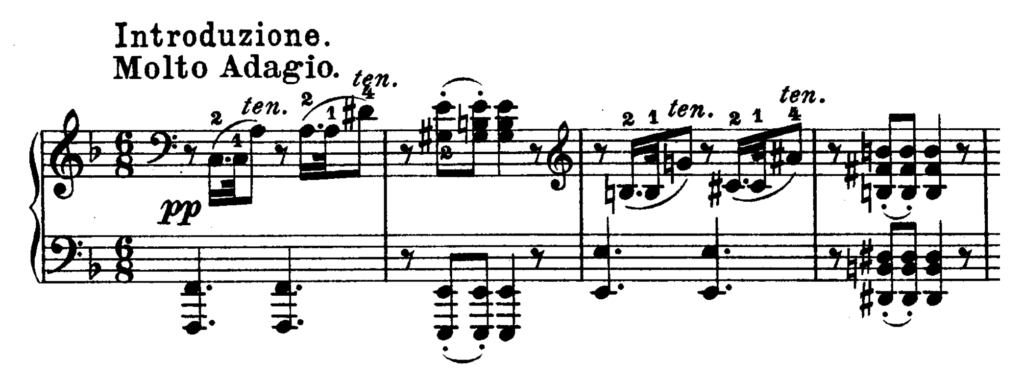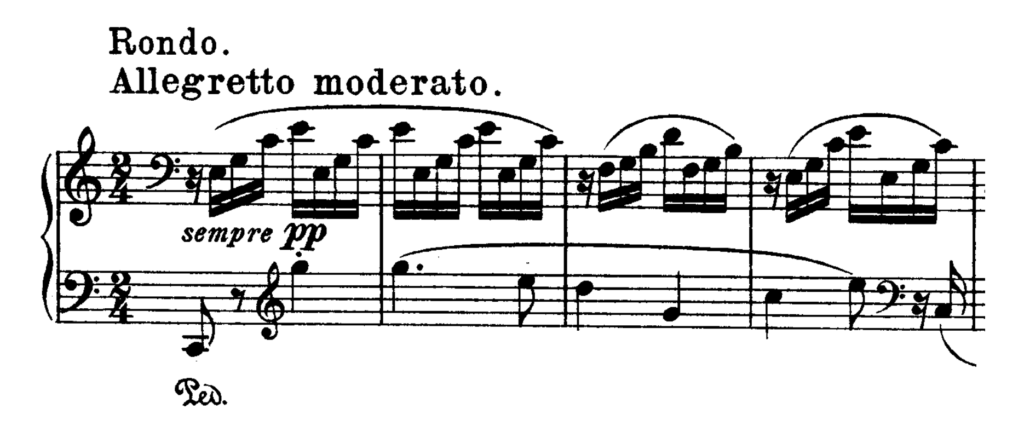Analysis
Contents
For the benefit of all pianists learning this work, we present to you a concise and easy to use analysis of Beethoven’s Piano Sonata No.21 in C major, Op.53 “Waldstein”
First Movement (Allegro Con Brio)
Form: Sonata Form. C Major.
EXPOSITION:
Bars 1-13: First Subject in C major (tonic). The first subject begins in the tonic key with a section of four bars, ending in G major, which is repeated a tone lower (Bars 5-8), with the exception of the note A flat in Bar 8, which is a tone and a half lower. This is followed by a four-bar section in C minor and a pause on the dominant. In the space of 13 bars the first subject modulates to G major, F major, F minor, and C minor; it ends on half-close upon the dominant, Bar 13.
Bars 14-35: Connecting Episode. The connecting episode begins (Bars 14-17) with the first section of the first subject, which is repeated (Bars 18-21) in D and A minor; Bar 22 is a repetition of Bar 21 with the sixth of the chord raised a semitone, forming an augmented sixth in the key of E minor, upon dominant (pedal point) of which there follows a brilliant passage in E minor, leading into E major.
Bars 35-74: Second Subject in E major. The second subject may be divided into two parts. The first part (Bars 35-42) is repeated (varied), Bars 43-50. Bars 50-74 constitute the second part. Both parts are in E major (instead of being in the dominant key).
Bars 74-82: Coda. The Coda consists of four bars, beginning in A minor and ending in E minor; Bars 74-77 repeated an octave lower, Bars 78-82.
Bars 82-85: Bars 82-85 form a passage leading to the repetition of the enunciation, after which, with the addition of Bars 88-91, it leads to the development; it is taken from the concluding part of the second subject.
Bars 88-91: Bars 82-85 form a passage leading to the repetition of the enunciation, after which, with the addition of Bars 88-91, it leads to the development; it is taken from the concluding part of the second subject.
Double bar and repeat.
DEVELOPMENT:
Bars 92-157: The development, which is very modulatory in character, commences with a reference to the first subject, Bars 3-4 of which furnish the materials for Bars 94-97; also for Bars 98-112. In Bars 98-100, Bars 3-4 are compressed into one bar; also in Bars 102-104. In Bars 101 and 105 only the fourth bar (compressed) is used, Bars 106-112 having only the third bar (compressed); Bar 113 leads to an elaborate development of the first portion of the second part of the second subject, Bars 114-144. A double pedal point of the tonic and dominant (Bars 144-157) prepared for the second entry of the first subject. This pedal point resembles that to be found at the close of the development of the first movement of Beethoven’s Fourth Symphony in B flat.
RECAPITULATION:
Bars 158-176: First Subject in original key. The first subject re-appears unaltered until Bar 70, at which bar A flat is used instead of G, and five bars are added, ending, Bar 176, in the tonic key.
Bars 176-198: Connecting Episode. The connecting episode begins as before (compare Bars 14-21 with Bars 176-183). Bar 22, however, is altered (Bar 184), and a bar added – Bar 185 – leading to the dominant of A minor; Bars 186-197 are an exact transposition of Bars 23-34.
Bars 198-237: Second Subject in A major and C major. The second subject re-appears in the key of A major. At Bars 202-205 it modulates through A minor to C major, in which key it ends (Bar 237)
Bars 237-End: Coda. The elongation of the Coda (Bar 251) is principally formed upon the first subject, with one reference to the second subject (Bars 286-296).
Second Movement (Adagio Molto)
Form: 3 parts. F Major.
FIRST PART:
Bars 1-9: Bars 1-9 form an introductory passage (Bar 7 is interpolated into the rhythm); it is sequential in form and modulatory; it begins and ends in the tonic key.
SECOND PART:
Bars 9-17: At Bar 9 a melody commences of eight bars.
THIRD PART:
Bars 17-28: At Bar 17 (overlapping the end of the melody), there is a recurrence of the opening passage, which is developed, and which forms another passage ending on the dominant of C, preparatory to the entry of the first subject of the Rondo.
Third Movement (Rondo – Allegro Moderato)
Form: Rondo Form. C Major.
FIRST PART:
Bars 1-62: First Subject in C major (tonic). Nearly the whole of the first subject (which begins and ends in the tonic key) is based upon the initial phrases, which are repeated with a varied accompaniment at Bar 31 and at Bar 55. Note the shake formed on inverted pedal point, Bars 51-62.
Bars 62-70: Bars 62-70 form a connecting passage.
Bars 70-98: Episode. At the concluding part of this episode in A minor there is a pedal point in the bass, Bars 87-98.
Bars 98-113: Bars 98-113 form a passage leading back to the tonic key, formed on the first subject.
Bars 114-175: First Subject in original key. The first subject re-appears here unaltered.
SECOND PART:
Bars 175-220: Episode in C minor. This episode begins with a subject of eight bars (Bars 175-183), which proceeds in sequence for four bars. The first phrase of eight notes in C minor is repeated in F minor (Bars 177-179). The first four notes are then used to commence a modulation to A flat major, the subject ending in that key (Bar 183). Bars 175-183 are then repeated with a triplet accompaniment (Bars 183-191). This subject is the inverted as regards its harmonic character; instead of the keys being in this order – C minor, F minor, and A flat major – the subject appears, Bars 191-199, in A flat major, modulating to F minor and ending in C minor. Bars 191-199 are repeated (inverted), Bars 199-207, the triplet accompaniment in the upper part being (with slight alterations) transferred to the underpart; Bars 203-207 are repeated (inverted), Bars 207-211; a reiteration of the final cadence brings the episode to a close in C minor.
Bars 221-312: Development. The development begins in A flat major with reference to the first subject (in chords), Bars 221-224, repeated in F minor, Bars 225-228, and in D flat major, Bars 229-232. A sequence in syncopations leads to a new figure (Bar 251); this modulates through several keys, and gives place (Bar 269) to another figure, which eventually modulates to C minor (Bar 277). Bars 295-312 consist entirely of dominant harmony, and end with full close in the tonic key (Bar 313).
THIRD PART:
Bars 313-344: First Subject (shortened) in original key.
Bars 344-378: Episode. This episode is formed upon the connecting passage, Bars 62-70. Bars 344-352 are varied and extended, Bars 352-377.
Bars 378-402: A connecting passage upon dominant pedal point leads to the Coda, “Prestissimo.”
Bars 401-End: Coda “Prestissimo.” The Coda is based almost entirely upon the first subject. It is referred to (in the original key), Bars 403-406; varied, Bars 407-410. In the key of F, Bars 427-428; varied, Bars 429-430. In original key, Bars 431-434; varied Bars 441-464. In the keys of C major (tonic), C minor, A flat major and F minor, Bars 485-506; and in original key, Bars 515-522. There are sequences in Bars 441-427 and Bars 434-440.









